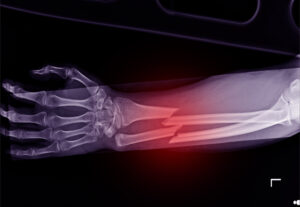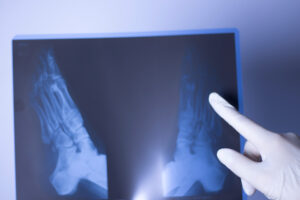Fractures could be missed for many reasons by paramedics, doctors and hospitals. Inexperienced medical professionals may fail to spot the clear symptoms of a fractured bone, whilst others may fail to request an x-ray or miss the break on a scan image. You could make a missed fracture claim if you can show medical staff failed to meet professional standards.
Key Points
- Fractures are one of the most common types of injury.
- Data published by the Royal College of Surgeons of England showed that between 2005/5 and 2013/14 there were over 2.4 million fracture admissions in England.
- Untreated fractures can lead to chronic pain, nerve damage, infection, bone death and could (if in the spine) lead to paralysis or death.
- Claims for medical misdiagnosis must be filed within the 3-year limitation period.
- A specialist medical negligence solicitor from our panel could use a No Win No Fee agreement to help you.
Please contact us if you want to know more about making a missed fracture compensation claim.
- Phone 0113 460 1216 to speak to an advisor.
- Use our contact form to make a free enquiry.
- Talk to us via our live support.

Frequently Asked Questions
- Can I Make A Missed Fracture Claim?
- What Compensation Could I Get For A Missed Fracture?
- How Could Negligence Result In A Fracture Being Missed?
- Examples Of Fractures That Could Be Undiagnosed
- What Are The Risks Of Leaving A Fracture Untreated?
- How Can I Know If My Fracture Was Missed?
- Is There A Missed Fracture Claim Time Limit?
- How Can I Prove My Fracture Was Missed Because Of Negligence?
- What Can Medical Negligence Claims Care Help Me With?
- Learn More
Can I Make A Missed Fracture Claim?
Yes, you could make a missed fracture claim if you can show that your case meets the eligibility criteria to do so. Whilst there may be specific factors which you need to show, the general criteria which must meet are;
- That a healthcare professional had a duty of care towards you. This duty of care is automatically established when you are under the care of any medical professional, such as a doctor, nurse or paramedic.
- That a medical professional (or healthcare service provider) failed to meet applicable standards. This may include those set by the General Medical Council or the Health and Care Professions Council, which sets standards for radiographers.
- The above breach led to you suffering harm. This harm was avoidable or unnecessary.
We should note that if the fracture is subsequently discovered before any further harm is suffered it is unlikely you could make a claim. Similarly, there may be circumstances in which a medical professional strictly adhered to professional standards and still did not diagnose the fracture. This may be the case with extremely rare fractures. In these instances, it is also unlikely you could claim compensation.
Can I Claim If My Fracture Was Misdiagnosed As Something Else?
Yes, you may be able to claim if your fracture was misdiagnosed as another condition, e.g, a strain or sprain. Your case will need to satisfy the same basic criteria as outlined above. Namely, that another equivalent medical professional would have correctly diagnosed the broken bone.
Can Claims Be Made On Behalf Of A Loved One?
You can make a claim on behalf of a loved one, such as a child, whose bone fracture was missed. Those with reduced mental capacity or who are below the age of 18 can not legally make a claim on their own behalf. Instead, a suitable adult will need to ask the court to act as the patient’s litigation friend. This is someone who makes decisions about the case for the person harmed, talks to the solicitor, and informs the claimant about how their case is progressing. The litigation friend may also need to pay costs as ordered by the courts.
Please get in touch with our advisors if you believe that a missed fracture diagnosis caused you harm. You may be eligible to make a missed fracture claim.
What Compensation Could I Get For A Missed Fracture?
If a hospital or doctor missed a fracture in your spine, it could lead to paralysis and leave you in pain. Under the Judicial College Guidelines (JCG), you could be awarded between £396,140 and £493,000 for tetraplegia. This document contains guidelines on what compensation may be awarded for different types of harm. It may be used by parties involved in calculating the value of the harm you suffered.
This part of your overall compensation settlement is called general damages and covers your pain and suffering. It may take the type of harm you suffered, how severe this was and what degree of recovery you are expected to make into account.
To create the following table, we have taken examples from the JCG. This is with the exception of the first row, which is an illustrative example of a settlement. Please also be aware that these are presented as guidelines, not definitive examples of what you may be awarded.
| Harm | Severity | Notes | Compensation |
|---|---|---|---|
| Multiple forms of harm + special damages. | Severe | Multiple forms of harm (physical or psychological) and special damages. | Up to £1,000,000+ if inclusive of special damages, such as for lost earnings. |
| Paralysis. | (A) Quadriplegia/ tetraplegia. | Factors such as pain and awareness of disability could be taken into account. | £396,140 to £493,000. |
| (B) Paraplegia. | The extent of pain and the person's life expectancy could affect the value of compensation. | £267,240 to £346,890. | |
| Pelvic or hip injury. | (A) Severe (i). | Extensive pelvic or hip fractures. | £95,680 to £159,770 |
| Neck injuries | (A) Severe (ii). | May include serious fractures or disc damage. | £80,240 to £159,770. |
| (A) Severe (iii). | Including fractures. | £55,500 to £68,330. | |
| Back injuries | (A) Severe (iii). | Fractures or other forms of harm leading to chronic conditions. | £47,320 to £85,100. |
| (B) Moderate (i). | Compression or crush injuries | £33,880 to £47,320. | |
| Arm injuries. | (D) Simple fracture of the forearm. | Simple bone fractures. | £8,060 to £23,430. |
| Shoulder injury. | (E) Clavicle fracture. | A fractured clavicle. | £6,280 to £14,940. |
You could also be compensated for certain financial losses experienced as a result of medical negligence. This could include:
- Medical expenses, such as the cost of further treatment (including surgery), medication, physiotherapy and long-term care.
- Loss of earnings and income. Your injury may have forced you to take time off work or it may have forced you to either reduce your hours or give up work. You could reclaim both lost earnings as well as entitlement to benefits in the workplace.
- Travel expenses. This may include travel to and from medical appointments, parking and other related costs.
Whilst medical negligence payouts can take account of these (and other) expenses, you must present evidence. You can submit invoices, bank statements and receipts.
You can learn more about how much compensation could be awarded for different types of harm and how it may be calculated by contacting an advisor.

How Could Negligence Result In A Fracture Being Missed?
There are many ways in which medical negligence could result in a fracture being missed. This may include where doctors fail to meet acceptable professional standards or where administrative errors are made. Below, we look at some examples.
- Administrative errors. You visit an A&E department with a suspected wrist fracture. The doctor orders a wrist x-ray. Due to an administrative error, your x-ray results are mixed up with another patient who did not have a fracture. Your fracture goes undiagnosed.
- X-ray errors. You visit the hospital with a suspected broken ankle. You are sent for an x-ray, however, the x-ray is performed improperly and does not show a break. You are subsequently diagnosed with a sprain or strain.
- Misinterpreting test results. A doctor can misinterpret your test results. Despite the x-ray clearly showing a broken foot, a doctor misinterprets it as a different condition.
- Inadequate examination. A doctor fails to carry out a competent and adequate physical examination of a patient. Therefore, they miss that a patient has a broken tibia.
- Failure to order tests or refer. A GP examines a patient and fails to refer them to the hospital or to order tests, instead diagnosing them with a soft tissue injury.
These are some examples of how negligence could happen. Whether you experienced GP misdiagnosis or negligence in a hospital, our advisors could help you. Please get in contact to learn more about making a missed fracture claim.
Examples Of Fractures That Could Be Undiagnosed
Examples of fractures which could go undiagnosed may involve more subtle breaks, those involving smaller bones or in areas where your symptoms could be mistaken for another condition.
Below, we look at some examples of commonly missed fractures,
- Scaphoid fractures. The scaphoid bone is a small bone in the wrist. Fractures could present with symptoms such as tenderness and wrist pain. The doctor fails to immobilise the wrist or order a follow-up examination within 2 weeks. This leads to the patient suffering avascular necrosis.
- Stress fractures. These could affect the femur, tibia or metatarsal bones (among others). Stress, or hairline fractures can develop over time from repetitive stress, such as when running. Negligence by a doctor could occur where they misinterpret test results, leading to a misdiagnosis of a strain. The patient may be left with permanent deformation in their foot bones.
- Occult hip fractures. Such fractures are not always apparent on an x-ray, especially in older patients. A doctor carries out physical examinations and orders an x-ray. The initial scan does not clearly show a fracture. They fail to order a follow up MRI or CT scan to confirm this (per NICE recommendations). This results in delayed treatment and a displaced fracture causing the patient pain and difficulty walking, even after subsequent treatment.
- Collarbone fractures. Hairline or non-displaced fractures may not be obvious on an x-ray. An initial x-ray is unclear. The doctor fails to order further testing and instead diagnoses a rotator cuff injury. The delayed treatment leads to chronic pain and improper healing.
These are some examples of circumstances in which a bone fracture may be missed. If your fracture was not properly diagnosed and treated you could be eligible to make a missed fracture claim.

What Are The Risks Of Leaving A Fracture Untreated?
There are a variety of different risks and potential complications if a fracture goes untreated. These complications and risks include:
Malunion Or Non-union Of The Bone
This is where the bone either fails to heal (non-union) or where it heals incorrectly (malunion). The risk of this is improper alignment of and instability in the bone. Depending on the location of the break, the risk of this could include reduced mobility, permanent disability and arthritis.
Example: femoral neck fracture goes untreated, it does not heal correctly and results in deformity as well as chronic pain.
Avascular Necrosis
Where blood flow to the bone is lost, tissue death could occur. This may be more prevalent in fractures of the hip or the scaphoid. In these examples, blood vessels can be disrupted.
Example: a hip fracture is not diagnosed or treated, causing blood flow to be lost. The loss of blood flow to the femoral head following a hip fracture, causes the bone to collapse. The patient requires hip replacement surgery.
Displacement
A displaced fracture is one which may shift and become unstable. This makes future treatment (once identified) harder.
Example: where a hip fracture is undiagnosed, the person may continue to walk on the affected hip, bearing weight. This could displace the fracture and require emergency surgery.
Disability And Chronic Pain
The lack of treatment leaves the person with limited movement and ongoing pain. This may be more so the case where the bone is weight-bearing, such as a leg or hip bone.
Example: a hip bone fracture misdiagnosed as a soft tissue injury could lead to persistent pain and reduced mobility. This could reduce the person’s future quality of life and ability to participate in daily activities.
Infection
Untreated open fractures and those close to joints can become infected. This can lead to serious health impacts.
Example: a hip fracture may present with micro-tears, which allow bacteria to enter. This could lead to osteomyelitis. Infections could lead to bone loss and sepsis. A severe infection can become life-threatening.
These and other risk factors could lead to patients suffering a range of complications, some of which may be severe. If you have experienced orthopaedic negligence, our advisors could help you.
How Can I Know If My Fracture Was Missed?
How you can know if your fracture has been misdiagnosed may depend upon the type of fracture you suffered, the bone affected and its severity. Hip fractures may present with a greater degree and range of symptoms than a scaphoid fracture, due to the hip being weight-bearing.
Potential symptoms of missed fractures could include,
- Worsening and persistent pain. Weight-bearing activity may make this worse.
- Bruising or swelling which does not improve.
- Reduced mobility and stiffness that continue after the anticipated recovery period.
- Visible deformities. This may be more evident in fractures of the hands, feet or those affecting joints.
- Crackling or grinding sensations when moving.
- Significant pain when resting, such as when sitting or at night.
These are some symptoms of undiagnosed fractures. If you experience these or other symptoms, it is advisable to consult a doctor or visit your hospital. Contact our advisors for a free initial consultation.
Is There A Missed Fracture Claim Time Limit?
As cited at the start of this guide, there is a time limit to claim for a missed fracture. If you are making a claim for yourself, the standard time limit (set by the Limitation Act 1980) is 3 years. This may be taken from the date on which the misdiagnosis occurred, or the date you discovered the misdiagnosis and harm. This is known as the date of discovery.
When you are claiming on behalf of a loved one unable to do so for themselves (such as those with reduced mental capacity or a minor), this time limit differs.
Time limits for minors do not begin until they are 18, whereas there is no time limit placed on those with reduced capacity. If the person does regain their capacity, the time limit would begin on this date.
If you are unsure how long you have to make a missed fracture compensation claim, get in touch with an advisor today who can discuss the incident with you and help decide if you are within the limitation period.
How Can I Prove My Fracture Was Missed Because Of Negligence?
You can prove that your fracture was missed due to negligence by collecting various types of evidence. Negligence equals a breach of duty plus harm. You will need to submit evidence proving the actions (or lack of actions) of a healthcare professional caused you to experience unnecessary pain and suffering. This may include:
- Your medical records which show your initial diagnosis, how you were treated and your subsequent medical treatment.
- Information on who treated you and where, including the name of the healthcare provider, medical professionals and dates on which you were treated.
- Photographs of visible harm, such as deformities.
- Witness details, so that they may be contacted and asked to provide a witness statement.
- Details of the incident that caused your bone fracture, ie, photographs of broken pavement if this caused you to trip and fall.
If you choose to work with a solicitor from our panel, they could help you to gather these and other forms of evidence. Please contact one of our advisors to see how a solicitor could help you.
What Can Medical Negligence Claims Care Help Me With?
At Medical Negligence Claims Care, we work with a panel of experienced solicitors. They are experts in helping people to claim compensation for medical negligence, such as missed fracture claims. If you choose to work with a solicitor from our panel, they will work diligently to ensure you get the compensation you deserve.
Following a free initial consultation with one of our advisors, you may be connected to a solicitor from our panel who could help you by:
- Explaining in more detail how the medical negligence claims process works.
- Advising you on how long you have left to claim.
- Filing your claim within the applicable time limit.
- Working with you to collect evidence of both medical negligence and financial losses.
- Organising an independent medical assessment carried out by an appropriate expert. This expert would review your medical records and produce a report which may be used as supplementary medical evidence.
- Negotiating with the other party and settling your case.
- Working under a No Win No Fee agreement.
The type of No Win No Fee agreement commonly used may be a Conditional Fee Agreement (CFA). A CFA means that the solicitor will only ask you to pay for their work (called a success fee) if you win your case. The success fee is charged as a legally limited percentage of your compensation. Details of this will be set in your CFA and agreed in advance with you. Any success fee is automatically deducted from your compensation.
Get In Touch With Our Advisors
You can get in touch with an advisor from our team today by,
- Calling us on 0113 460 1216
- Making an inquiry using contact form.
- Using our live support.

Learn More
Learn more about fracture diagnosis and treatment as well as making a claim in these guides.
- You can find out what a litigation friend is in this guide.
- Read our guide on how to claim compensation for a missed wrist fracture here.
- Learn more about what Never Events are and how to claim compensation in this guide.
References.
- Read the NHS Constitution for England in this government resource.
- Learn about your choices in the NHS in this resource.
- The National Institute for Health and Care Excellence publishes guidance on the management of fractures here.
Thank you for reading our guide on how to make a missed fracture claim. Contact us for further information about claiming for medical negligence or to get help from a medical negligence solicitor.

